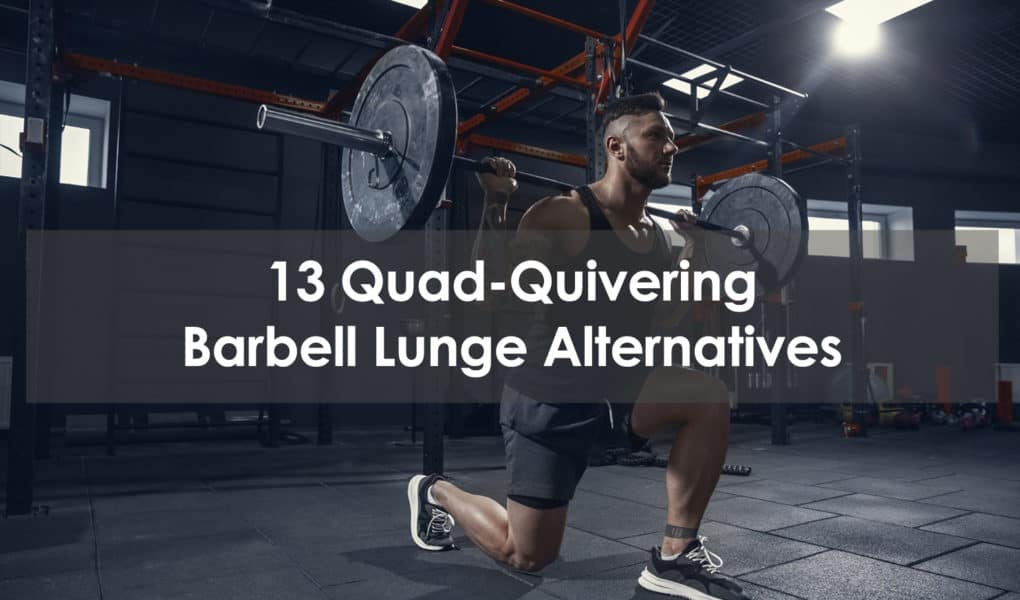The barbell lunge is one of the most effective exercises that exist to work your lower body. Whether done with bodyweight or resistance, the lunge movement will target your quads, glutes, and hamstrings. It is also a functional move that enhances your range of motion and agility.
Yet, there’s more to this exercise than the standard barbell lunge. In this article, I’m about to lay out for you 13 super effective barbell lunge alternatives and variations to hot your key lower body muscle groups from every angle.
1. Walking Lunge
Why it’s a great alternative + muscles worked
The walking lunge adds a dynamic movement aspect to the traditional lunge exercise. This enhances functional strength and hip mobility.
Equipment used
Dumbbells
Step-by-step how-to
- Stand with your feet hip-width apart and dumbbells in hand.
- Take a large step forward with your right leg and go down into a lunge with your left knee just off the ground.
- Follow through with your left foot to advance into a large step forward.
- Continue lunging forward in this manner for 5 steps.
- Turn and take 5 lunge steps back to the start position.
- Perform 3 sets of 5 forward and backward steps.
Tips
Maintain an upright torso throughout the movement.
2. Cross Over Extensions
Why it’s a great alternative + muscles worked
Cross-over extensions do a great job of addressing hips dip, while also strengthening the inner quad and hamstrings.
Equipment used
None
Step-by-step how-to
- Get down on the floor on all fours.
- Bring your straight left leg directly out laterally, pointing the toes out.
- Now bring the extended leg up and back to full extension.
- Reverse and repeat.
- Perform 3 sets of 12 reps on each leg.
Tips
Keep the extended leg straight with toes extended throughout the movement.
3. Kettlebell Deadlift
Why it’s a great alternative + muscles worked
The kettlebell deadlift effectively hits the hamstrings as well as the lower back and biceps with a dynamic compound movement.
Equipment used
Kettlebell
Step-by-step how-to
- Start with feet shoulder-distance apart, toes pointed slightly out, and kettlebells in hand.
- Hinge at the hips to go down to the floor with straight arms at your sides.
- When the kettlebells are about 3 inches from the floor, push through the heels to return to the start position.
- Do 3 sets of 12-15 rep.
4. Drop Down Squats
Why it’s a great alternative + muscles worked
The drop-down squat places emphasis on the front quads with a plyometric component that adds a cardio element. Muscles worked are the quads, glutes, and hamstrings.
Equipment used
None
Step-by-step how-to
- Stand with your hands together in front of your chest and feet together.
- Jump your feet apart and dynamically descend down into a full squat position.
- Immediately jump back to the start position.
- Perform 3 sets of 15-20 reps.
Tips
Perform your reps fluidly in a ‘hot potato’ fashion.
5. Machine Split Squats
Why it’s a great alternative + muscles worked
Machine split squats is another barbell squat variation that intensifies the stress on the front part of the quads while also allowing for unilateral tension on each leg. This exercise works the quads, glutes, and hamstrings.
Equipment used
Smith machine
Step-by-step how-to
- Set the bar on a Smith machine at shoulder level. Get under the bar and assume a staggered stance, with your right foot forward.
- Unrack the bar and lower down to a bottom lunge position.
- Push through the front thigh to return to the start position.
- Do 4 sets of 8-12 reps.
Tips
Keep your torso upright, maintaining a neutral spine position.
6. Band Squat with Abduction
Why it’s a great alternative + muscles worked
The band squat with abduction places emphasis on the outer quadriceps as well as enhancing your lateral lower body agility.
Equipment used
Step-by-step how-to
- Stand with feet wider than shoulder-width apart, a resistance band looped over your ankles. Clasp your hands together in front of your chin.
- Descend down into a parallel squat. When you come out of the squat, extend your straightened right leg out to the side.
- Immediately move into your next squat. When you come out of it, move the opposite leg out laterally.
- Perform 3 sets of 15 reps.
Tips
This can be a challenging exercise balance-wise for some. If needed, stand next to an upright and hold it for support with your hand.
7. Thruster + Abduction
Why it’s a great alternative + muscles worked
The thruster and abduction is a dynamic lower body move that boosts your glute power while also strengthening the outer thighs.
Equipment used
Resistance loop band
Step-by-step how-to
- Position yourself on an exercise mat, face-up on all fours with a loop resistance band around the mid-thighs.
- You should be resting on your palms and your feet, with your knees bent and together.
- From this starting position, thrust your pelvis as high as possible. Then push your thighs apart.
- Bring your thighs back together and then lower to the start position.
Tips
Hold the contracted position as you tightly squeeze your gluteus maximus muscle.
8. Cross Lunges + Front Row
Why it’s a great alternative + muscles worked
The cross lunge and front row combine the strengthening benefits of the regular lunge with the balance and coordination of the cross-over movement pattern and adding the deltoid building effects of the front-row movement. Muscles worked are the quads, glutes, hamstrings, and front deltoids.
Equipment used
Resistance loop band
Step-by-step how-to
- Stand with feet hip-distance apart and a thin resistance loop band held in your extended arms at shoulder level.
- From this starting position, extend your left foot behind you and to the right into a lunge position. Simultaneously pull the band apart to perform a front raise.
- Reverse and repeat.
- Do 3 sets of 15-20 reps.
Tips
Alternate sides as you perform your rep count.
9. Dumbbell Hack Squat
Why it’s a great alternative + muscles worked
The dumbbell hack squat is a great move to target the hamstrings and lower back without placing stress on the spine. This exercise works the quads, glutes, and hamstrings.
Equipment used
Dumbbells
Step-by-step how-to
- Stand with a pair of dumbbells behind your body resting against your hamstrings.
- From this starting position, descend into a squat position, bringing your quads forward over your toes.
- Push through the heels to return to the top position.
- Do 4 sets of 8-12 reps.
Tips
Maintain an upright torso and keep the dumbbells in your rear at all times.
10. Banded Static Lunge
Why it’s a great alternative + muscles worked
The banded static lunge is a variation of the standard lunge that increases your time under tension in the lunge position for increased intensity and greater strength and growth potential. Muscles worked are the quads and glutes.
Equipment used
Resistance band
Step-by-step how-to
- Place yourself before a chair and out a booty band around your mid quads.
- Now place your left foot on the chair behind you and clasp your hands together in front of your chest.
- From this starting position, lunge your left leg so that the knee almost touches the floor.
- Push through the right thigh to return to the start position.
- Do 3 sets of 10-15 reps.
Tips
Be sure to do the same number of reps on each side.
11. Landmine Reverse Lunge
Why it’s a great alternative + muscles worked
The landmine reverse is an explosive power movement that builds lower body strength and power. It works the quads, glutes, and hamstrings.
Equipment used
Landmine bar
Step-by-step how-to
- Stand before a loaded landmine bar, facing it and assuming a staggered position with the right leg forward.
- Grab the end of the bar with your right hand.
- From this starting position, drop down into the bottom lunge position, with your bottom knee about three inches from the floor.
- Do 3 sets of 15 reps on each side.
Tips
Keep your body upright; do not allow your lower back to round.
12. Proprioception lunge
Why it’s a great alternative + muscles worked
The proprioception lunge adds the element of instability to the lunge movement. This increases your balance and coordination while building strength and size through the lower body. It works the thigh muscles, hamstrings, and glutes and helps to address muscle imbalances.
Equipment used
Bosu ball
Step-by-step how-to
- Assume a staggered position with your front foot on a Bosu ball.
- From this starting position, drop down into a lunge position with the rear knee just off the ground.
- Push back up to the start position.
- Do 3 sets of 15 reps on each leg.
Tips
Maintain your center of balance in order to stay upright while doing this unstable exercise.
13. Dumbbell Low Lunge
Why it’s a great alternative + muscles worked
The dumbbell low lunge adds the extra element of a low row to the standard lunge to bring the upper body into the movement. as a result it works not only the quads, hamstrings, and glutes but also the lats and deltoids.
Equipment used
Dumbbells
Step-by-step how-to
- Assume a starting position with feet shoulder-distance apart and dumbbells in hand at your sides.
- Take a large big forward step to lunge down and bring your rear knee completely to the ground. Simultaneously bring the dumbbells down to touch the floor.
- Push back to the start position.
- Do 3 sets of 15 reps.
Tips
Make sure to bring your arms forward to drop the weights all the way to the floor on every rep. Keep your core tight throughout the movement.
Conclusion
With the 13 alternatives to barbell lunges that I’ve just presented, you now have a powerful arsenal of leg exercises to allow you to blast your legs from all angles and with maximum efficiency.
Combine 3 or 4 exercises to create your workout routine, performing a total of between `14-19 sets for your quads. Vary your rep range between a high of 30 reps and a low of 6 reps with your heaviest weight. Hit your quads once every five days for maximum growth potential.
Frequently Asked Questions
What is better front or back lunges?
Front and back, or rear, lunges work put the emphasis on a different muscle group. The front lunge primarily works the quadriceps and glutes, while the rear lunge shifts the emphasis to the hamstrings and glutes. So, the best exercises depend on what your training goal is – to focus on quads, do front lunges, and hit the hamstrings to the rear lunge.
What muscles are used in lunging?
The lunge exercise works the three major muscles of your lower body – the quadriceps, hamstrings, and glutes.
What is the best form of lunges?
There are many variations of the lunge. The best one for you depends on what your training goal is. However, for overall mass and strength gains through the quads and provide maximum range of motion weighted Bulgarian splits squats is my personal favorite.







